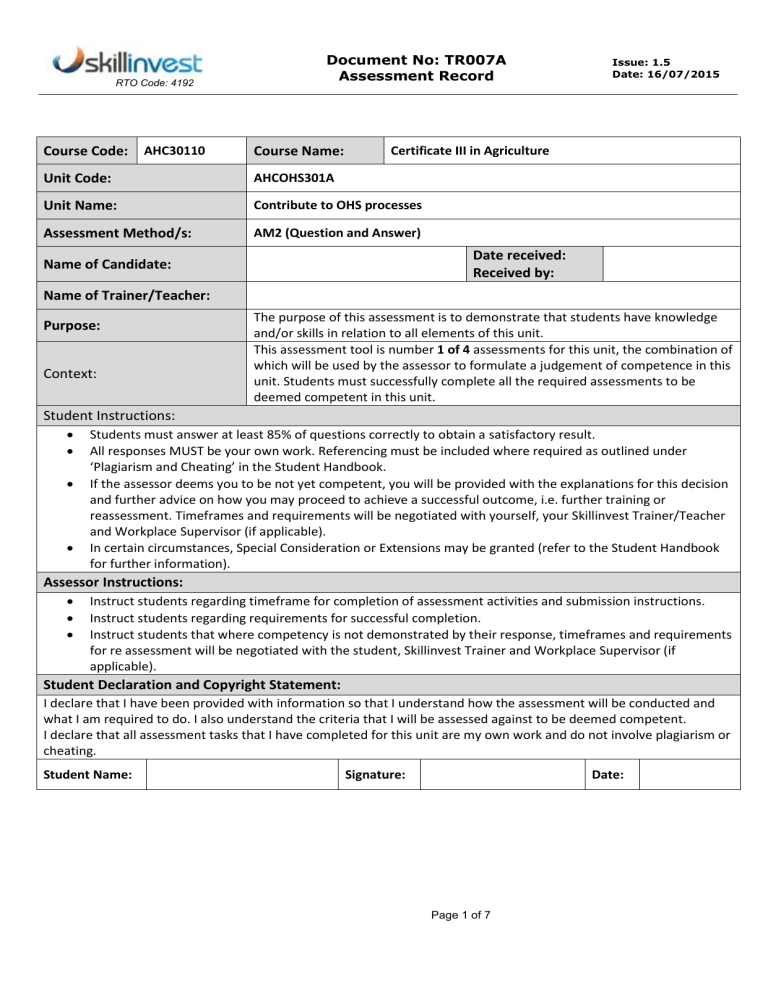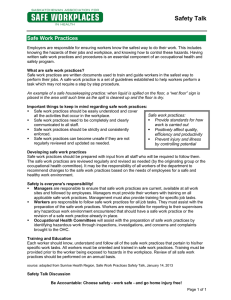
RTO Code: 4192 Course Code: AHC30110 Document No: TR007A Assessment Record Course Name: Issue: 1.5 Date: 16/07/2015 Certificate III in Agriculture Unit Code: AHCOHS301A Unit Name: Contribute to OHS processes Assessment Method/s: AM2 (Question and Answer) Date received: Received by: Name of Candidate: Name of Trainer/Teacher: Purpose: Context: The purpose of this assessment is to demonstrate that students have knowledge and/or skills in relation to all elements of this unit. This assessment tool is number 1 of 4 assessments for this unit, the combination of which will be used by the assessor to formulate a judgement of competence in this unit. Students must successfully complete all the required assessments to be deemed competent in this unit. Student Instructions: Students must answer at least 85% of questions correctly to obtain a satisfactory result. All responses MUST be your own work. Referencing must be included where required as outlined under ‘Plagiarism and Cheating’ in the Student Handbook. If the assessor deems you to be not yet competent, you will be provided with the explanations for this decision and further advice on how you may proceed to achieve a successful outcome, i.e. further training or reassessment. Timeframes and requirements will be negotiated with yourself, your Skillinvest Trainer/Teacher and Workplace Supervisor (if applicable). In certain circumstances, Special Consideration or Extensions may be granted (refer to the Student Handbook for further information). Assessor Instructions: Instruct students regarding timeframe for completion of assessment activities and submission instructions. Instruct students regarding requirements for successful completion. Instruct students that where competency is not demonstrated by their response, timeframes and requirements for re assessment will be negotiated with the student, Skillinvest Trainer and Workplace Supervisor (if applicable). Student Declaration and Copyright Statement: I declare that I have been provided with information so that I understand how the assessment will be conducted and what I am required to do. I also understand the criteria that I will be assessed against to be deemed competent. I declare that all assessment tasks that I have completed for this unit are my own work and do not involve plagiarism or cheating. Student Name: Signature: Date: Page 1 of 7 Document No: TR007A Assessment Record RTO Code: 4192 Assessor Feedback and Comments Issue: 1.5 Date: 16/07/2015 Verbal Feedback Provided Assessment Only Result Skillinvest Assessor to complete: Satisfactory / Not Satisfactory (circle one) If Not Satisfactory, date for re-assessment: Skillinvest Assessor Declaration: I declare that the assessment has been conducted in accordance with the principles of assessment and the rules of evidence. I confirm that the student has been advised of the right to appeal the assessment outcome. Skillinvest Assessor: Signature: Date: Final Unit Result Only (only complete if this is the final assessment) To be completed when all required assessments as per TR006 Learning and Assessment Mapping Tool (or equivalent) have been finalised. This section is not required to be completed where the TR007A Unit Assessment Record is utilised. Assessor Feedback and Comments (provided to candidate at end of unit): Verbal Feedback Provided Unit Result Assessment Tool Satisfactory Not Satisfactory Not Applicable Comment Assessment Tool 1 Assessment Tool 2 Assessment Tool 3 Assessment Tool 4 Skillinvest Assessor to complete: CY / NYC (circle one) If NYC, date for re-assessment: Skillinvest Assessor: Signature: Date: Page 2 of 7 RTO Code: 4192 Document No: TR007A Assessment Record Issue: 1.5 Date: 16/07/2015 1. Workers can contribute to safety in the workplace by identifying hazards, assessing risk, making changes to address an identified hazard a. True b. False 2. Under the OH&S Act, employees are responsible for: (Select one or more alternatives) a. b. c. d. Collecting safety information for use in their workplace Providing items of PPE which are required for their workplace Developing standard Operating procedures for the tasks they perform Taking reasonable care of his or her own health and safety 3. Under the OH&S Act, employees are responsible for: (Select one or more alternatives) a. b. c. d. Appointing staff to manage safety in the workplace Ensuring that each employee cares for their own health and safety Ensuing that damages items of equipment are reported to work cover Providing a safe work environment 4. If an employee can see that a workmate is not wearing hearing protection operating a noisy machine then the employee is required to point out the risk and offer hearing protection to the workmate. a. True b. False 5. Employers need to establish plans and procedures to cope with fire and other emergencies. Emergencies can result from events such as leaks or spills, fire or explosions, mechanical failures or other incident. a. True b. False 6. Emergency plans should include:(Select one or more alternatives) a. b. c. d. warning, alarm and sprinkler systems first aid facilities available and location of emergency equipment accessibility of lists of emergency organisations with contact details, key personnel with their contact details and responsibilities Page 3 of 7 RTO Code: 4192 Document No: TR007A Assessment Record Issue: 1.5 Date: 16/07/2015 7. Hazards are the main identifiable cause of workplace health and safety problems. They can consist of: a. b. c. d. machinery electrical hazards poor management systems and procedures Human behaviour. 8. Physical hazards include electricity, noise, temperature, lighting, radiation and vibration a. True b. False 9. Which of the following statements are true? (Select one or more alternatives) a. All the types of potential hazards present in a particular job or task need to be considered and the risks presented by these hazards need to be assessed to work out how likely they are to cause harm, and how serious the harm might be b. A hazard is anything with the potential to harm life, health or property. c. OHS risk analysis consists of correctly adjusting the seat before operating a tractor. d. Employers need to recognise of any kind of hazards that exist in the workplace, and not consult workers 10. The hazard identification and risk control process can be simple or complex however the principles remain the same. (Select one or more alternatives) Risks need to be: a. Ignored when you are under time pressure b. Taken in order to be efficient c. Controlled by the supervisor only d. Evaluated and reviewed 11. Under the Occupational Health and Safety Act the employer must provide adequate information, instruction, training and supervision to employees so that they can work in a way that is safe and without risks to health. a. True b. False Page 4 of 7 RTO Code: 4192 Document No: TR007A Assessment Record Issue: 1.5 Date: 16/07/2015 12. An MSDS is a document containing important information about a hazardous chemical, it should contain (Select one or more alternatives) a. b. c. d. e. A hazardous substance's common name What the hazardous substance tastes like The chemical and physical properties of the hazardous substance Health hazard information The manufacturers or importer's name, Australian address and telephone number. 13. It is appropriate to use mechanical equipment if the guard has been removed for cleaning because it will not be off for very long a. True b. False 14. Which of the following statements are true: (Select one or more alternatives) a. Only experienced operators should use unsafe mechanical equipment. b. If you are asked to use a machine that has been modified but you think may be unsafe you must do as you are told. c. Inexperienced operators should use the oldest machines in case they damage the new ones d. There is no need for experienced operators to do pre operational checks 15. If you are experienced in using a piece of mechanical equipment, you do not need to pay as much attention as someone who is new to using it. a. True b. False 16. An ‘Out of Service’ tag means it’s alright to use the equipment but not very often, and you need to be extra careful. a. True b. False 17. It is all right to eat your lunch in the area where you use hazardous substances a. True b. False Page 5 of 7 RTO Code: 4192 Document No: TR007A Assessment Record Issue: 1.5 Date: 16/07/2015 18. Reading the label and the MSDS can help you tell how a hazardous substance may cause you harm a. True b. False 19. Which of the following statements are correct? (Select one or more alternatives) a. A place of work may use many different hazardous substances. b. Everyday chemicals such as cement, cleaning liquids and powders are not hazardous substances. c. How dangerous a hazardous substance is has no bearing on the type of substance it is or how it enters the body. d. Safety directions for the use of any product are written on the label. 20. Reading the label and the MSDS will provide information on what to do should you suspect unsafe exposure to the substance has occurred. a. True b. False 21. Which of the following statements are incorrect? (Select one or more alternatives) a. If you hear ringing in your ears after doing a noisy job there is no need to tell anyone because it will go away after a while b. Excessive noise destroys delicate nerve cells in the inner ear that transmit sound messages to the brain resulting in lasting hearing loss. c. You are operating in a normal situation if you need to increase your voice to make yourself heard a metre away. d. Moving the source of noise has little or no impact on people working in the area. 22. Excessive noise can cause permanent hearing loss a. True b. False 23. Taking regular breaks can help reduce the risk of some manual handling injuries. a. True b. False Page 6 of 7 RTO Code: 4192 Document No: TR007A Assessment Record Issue: 1.5 Date: 16/07/2015 24. Unsafe manual handling activities can cause strains and sprains a. True b. False 25. OHS instructions might be: (Select one or more alternatives) a. b. c. d. Taking regular breaks Eating a snack Using PPE Lifting techniques 26. Which of the following are forms of safety instruction? (Select one or more alternatives) a. b. c. d. e. f. The safety sign A copy of your award wage agreement. The business mission statement Information written down in a safety manual, or in the organisation’s policies Information told to you verbally by someone like your supervisor, or co-worker. An information sheet, poster or notices displayed in your work area. 27. There are a number of ways you can contribute to a safer workplace a. understanding how OHS consultation and communication should be managed in the workplace b. improving your communication skills c. making sure that you understand the safety rules in your workplace 28. other persons authorised or nominated by the enterprise can be a. b. c. d. perform specified work approve specified work inspect specified work as they please Result: / 28 = Page 7 of 7 %
